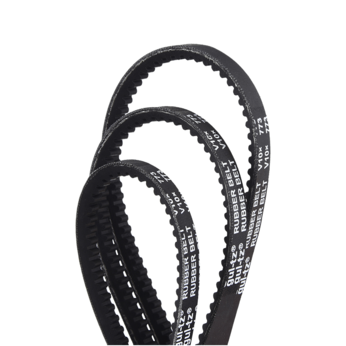How does the tooth design of synchronous timing belts affect its performance
Tooth design plays a vital role in the performance of synchronous belts, directly affecting their synchronization accuracy and transmission efficiency. Unlike traditional friction belts, synchronous belts rely on precise meshing between the tooth profile and the wheel to achieve power transmission. High-precision tooth design ensures that the phase relationship between the pulleys is stable during the transmission process, avoiding relative slip, thereby ensuring the accuracy of movement. If there are significant errors in the tooth design, especially under high-speed operation conditions, it may lead to cumulative positioning errors, which in turn affect the overall accuracy of industrial automation, CNC systems and precision equipment. Therefore, the use of optimized arc teeth or modified tooth structures can effectively improve the meshing accuracy, reduce backlash, and improve the control accuracy of the entire transmission system.
The structural characteristics of the tooth profile not only affect the synchronization accuracy of the synchronous belt, but also significantly affect its load capacity and fatigue resistance. Different types of tooth profiles have different contact areas and contact modes with gears during meshing. For example, trapezoidal teeth are prone to local contact at the top of the tooth during transmission, resulting in higher contact stress. The improved arc teeth and HTD tooth profiles increase the force-bearing area through arc surface contact, reduce the stress concentration per unit area, thereby significantly improving the load-bearing capacity and extending the fatigue life of the belt body. Under heavy load, high frequency and high-speed operation conditions, these improved tooth profiles show better durability and structural stability, effectively avoiding problems such as tooth surface peeling and fracture caused by stress fatigue.
Tooth profile design is also directly related to the overall efficiency of the transmission system. Reasonable tooth profile can achieve efficient power meshing process, ensure smooth bite between teeth and wheel grooves, minimize meshing resistance and sliding friction, and thus improve transmission efficiency. High-quality toothed belt efficiency can usually reach more than 98%, which is far higher than traditional friction transmission systems. Especially in the case of frequent load changes or frequent system start-stop, excellent tooth profile design can significantly reduce power loss and improve the overall energy efficiency of the system, which is of great significance to achieve energy saving and consumption reduction.
In addition, the noise and vibration levels of the toothed belt during operation are also closely related to the tooth structure. A well-designed tooth profile can ensure smooth transition during engagement and disengagement, and avoid mechanical vibration and noise caused by impact and interference. The use of a modified tooth profile structure with a buffer curve can effectively reduce the impact load at the initial stage of engagement, optimize the dynamic response during power transmission, and improve the smoothness and quietness of operation, especially in high-speed and high-precision environments. In addition, some tooth profiles are combined with high-performance elastic materials to further alleviate the impact stress on the tooth surface, making the entire transmission process softer, reducing the impact of vibration on other components of the system, and thus improving the operating reliability and service life of the equipment.
In terms of dynamic response characteristics, tooth profile design also plays a direct role. During the transmission process, the power needs to respond quickly to system changes through the toothed belt, especially in high-frequency load fluctuations and acceleration and deceleration processes, which puts higher requirements on the flexibility of the belt body and the precise matching of the tooth profile. Through precise tooth profile design combined with high-strength tensile layer materials, it can ensure that the synchronous belt has excellent instantaneous response capabilities and avoids tooth skipping or hysteresis, thereby meeting the needs of modern automated production for rapid start-up, precise positioning and stable braking.
Hot Products
-
 View More
View More
-
 View More
View More
V-belt For Industry
-
 View More
View More
T Type Industry Rubber Synchronous Belt
-
 View More
View More
Toothed wedge belt
-
 View More
View More
Thickened timing belt
-
 View More
View More
Open Timing Belt
-
 View More
View More
Automotive V-belt
-
 View More
View More
Rubber Flat Belt
-
 View More
View More
Ribbed Belt
-
 View More
View More
Synchronous Pulley
-
 View More
View More
Arc tooth industrial rubber synchronous belt
-
 View More
View More
Automotive timing belt

 English
English 简体中文
简体中文
